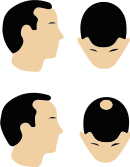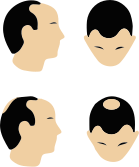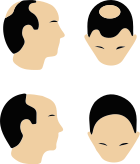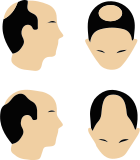20 years Changing lives through Hair Transplant in Tijuana, Mexico
We are experts in hair and beard transplant. We use both FUE (Follicular Unit Extraction) and FUT (Follicular Unit Transplantation) techniques, with totally natural results.

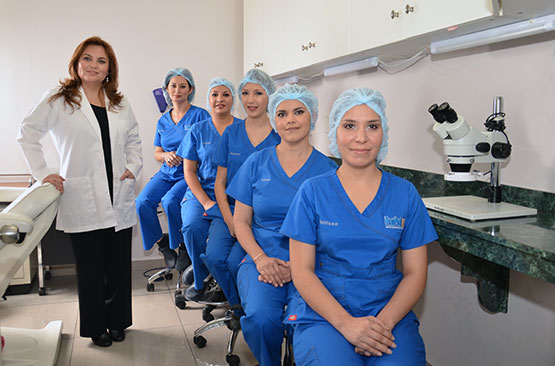
Gabriela Hernandez Amaya MD, expert in both FUE and FUT techniques in Tijuana.
We have over 20 years of experience performing hair transplantation and still surprise’s me to see patients arriving from all over the world USA, Canada, Japan and Australia. I’m always surpassing my own goals, I’m committed to be the best in what I do and how I performed this procedure.
Here at Neopel Hair Clinic we can provide an alternative to patients with baldness problems through a hair transplant surgery.

FUE (Follicular Unit Extraction)
This hair transplant surgery is far less invasive than traditional strip surgery. There is no use of scalpel or staples or sutures.
FUE (Follicular Unit Extraction)
FUE is far better described as a “procedure” than as a “surgery.” With this technique the donor area is shaved down to the skin so the individual follicular units (FU’s) are exposed.
FUT (Follicular Unit Transplant)
This method has a lower incidence of graft transection because the removed strip can be processed under a brightly-lit, high-powered microscope.
FUT (Follicular Unit Transplant)
That allows us to see exactly where the hair is growing under the skin. This clear view allows us to precisely position the scalpel to ensure the integrity of each graft is maintained.
FHT (Facial Hair Transplant)
A beard transplant is a process , that involves extracting donor hair on the back or sides of hair.
FHT (Facial Hair Transplant)
The new facial hair typically grows like normal beard. To ensure natural appearing beard, careful placement of the grafts at the correct angle and proper direction is required.
The Norwood Scale: How bald are you?
If you start to thin or recede early in life, there’s a good chance you’re destined to lose quite a bit of hair.
Stage 2
Initial signs of baldness are becoming evident.
Stage 3
Represents the lowest extent of hair loss considered sufficient to be called baldness.
Stage 4
There is a decisive lack of hair on the Crown.
Stage 5
The band of hair extending across the crown is noticeably narrower and thinner.
Stage 6
The bridge of hair that once crossed the crown is now been lost with only sparse hair remaining.
Stage 7
This is the most advanced or severe form of hair loss. Only a narrow band of hair in a horseshoe shape survives on the sides and back of the scalp.
What our patients say
I had the FUE procedure done three weeks ago, and my experience exceeded my expectations. Dr. Hernandez met with me via zoom for a free consultation. She answered my questions and concerns. After the consultation I had more questions and her secretary was always very helpful and friendly. Always answered my emails in a timely manner.
Neopel provided transportation for me. They picked me up in San Diego, and after surgery brought me back. They also provided snacks and lunch after surgery.
All nurses were very nice and professional. They made sure I was always comfortable. Dr. Hernandez and her husband did an excellent job. Very little discomfort during surgery, and no pain what so ever after surgery. I highly recommend Neopel. Feel free to send me a message if you have any questions, and I am happy to share more about my experience. It’s has only been three weeks and I already see a difference, and feel great.
This place is amazing!
Doctor Hernandez and doctor Miguel with their team are very knowledgeable and they will give you the best service that you can ever imagine at a fraction that you can spend in US,the facility is very safe,clean and very close from the border.
I just got my surgery and to see the final results is gonna take a while but I can tell already that they did a great job.
Don’t give up on your hair!
Bless
I had the best experience! Doctor was knowledgeable and the staff was very friendly. The clinic was clean and so far results are amazing. Highly recommend coming her. Staff and doctor speak both languages.
FAQ about Hair Transplant
We know that you have many questions about hair restoration, so this is some of our answers.
Can home remedies cure baldness?
You may be wondering if you can use home remedies for hair growth or if there are any effective natural hair growth remedies. A healthy, nutritious diet is a great place to start; vitamin and iron deficiencies can be detrimental, so eating a variety of vitamin-rich foods is one of the best home remedies for hair loss. However, studies show that most home remedies have mixed results, so consider other options.
If your hair loss is genetic, home remedies for hair growth are unlikely to be an effective treatment for baldness (you are more likely to have success with approaches such as medication, laser therapy, or hair transplantation surgery). It is a good idea to ensure you have a healthy lifestyle (for example, by reducing stress, smoking, and alcohol consumption, which can all cause or exacerbate hair loss). Avoid websites offering miracle cures, since they are rarely effective.
Do non surgical hair restorations work?
If you feel squeamish about surgery, you are probably wondering about non-surgical hair replacement options. Depending on the cause of your hair loss, you may find that improving your nutrition, reducing stress levels, and treating undiagnosed illnesses or vitamin deficiencies may allow your hair to grow back. However, if your hair loss is caused by alopecia, you are less likely to find success with these non-surgical hair replacement techniques.
There are medications used as a treatment for baldness, some of them work very well, you need to ask your medical provider about options for your case. Other hair replacement options include laser combs and laser therapy at your physician’s office, although these hair loss cures have varying levels of success from one individual to another. Finally, if none of this works and you are set on avoiding surgery, you may consider experimenting with flattering hairstyles or simply shaving off the rest of your hair for a stylish new look.
How much does hair restoration cost?
How much does a hair transplant cost? Individuals considering hair transplantation surgery often wonder about hair restoration prices. To determine the hair replacement cost, you must first decide on the type of procedure you are considering.
Follicular Unit Extraction (FUE) will typically cost more than strip harvesting, but often results in a more natural appearance and involve less scarring and post-surgical pain. However, there are advantages and disadvantages to both procedures.
When considering hair replacement cost, it is important to keep in mind the value of the surgery. How much does the hair transplant cost when compared to an artificial hairpiece, or the long-term use of medical treatments, and/or laser therapy? Moreover, because the results are permanent, many people view the surgery as an investment in their appearance and overall happiness.
What causes hair loss in men?
Men experiencing thinning hair will typically wonder about the reasons for their hair loss. So why do men lose hair? The causes of hair loss in men vary widely, but alopecia – genetically inherited, male pattern baldness – is what causes male baldness most often.
Nevertheless, there are many other reasons for hair loss, ranging from illness (including thyroid disease and anemia), medications (such as chemotherapy), and lifestyle, including stress, exposure to chemicals or UV rays, smoking, or the consumption of alcohol.
However, all of these factors will affect different individuals in various ways. For example, not everyone who experiences stress or has a family history of male pattern baldness will be affected in the same way. Thus, in most cases, the best option for determining the causes of hair loss in men is to see a physician.
How to regrow hair?
Men and women experiencing hair loss will often wonder about hair regrowth options. Hair regrowth treatment will vary depending on the cause of your hair loss. Because the reasons for thinning hair vary widely, the solution may range from making lifestyle changes (such as reducing stress or eating a more healthy, nutritious diet) to treating existing medical problems (such as thyroid disorders or anemia) or seeing a physician to discuss medical treatments.
Hair regrowth for men and women can be stimulated using hair regrowth treatments such as laser therapy or laser combs. If none of these treatments are effective, surgical options such as follicular unit extraction (FUE) are also available. Hair regrowth for women may also be affected by pregnancy, so if you are a pregnant woman experiencing thinning hair, know that this problem will resolve itself in time.




